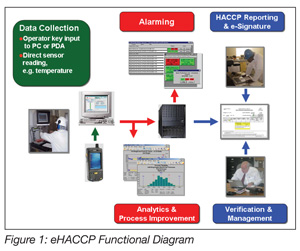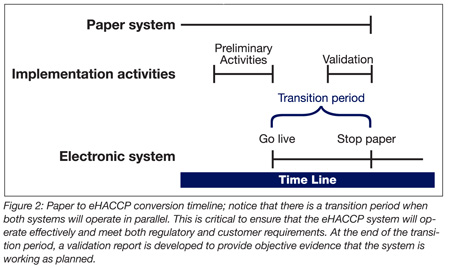The majority of existing Hazard Analysis Critical Control Point (HACCP) programs were implemented a decade ago. These programs were generally designed as paper-based data collection and record-management systems. In the intervening years, the limitations of paper based systems have become painfully clear:
• Labor-intensive operations
• Transcription errors
• Difficult and time-consuming record retrieval and reporting
• Cost and space requirements for record storage
 We have been researching the requirements to create a viable electronic HACCP (eHACCP) system that successfully manages the operational aspects of HACCP from collecting data to validating and reporting results (Figure 1). An effective eHACCP system must contain the following components:
We have been researching the requirements to create a viable electronic HACCP (eHACCP) system that successfully manages the operational aspects of HACCP from collecting data to validating and reporting results (Figure 1). An effective eHACCP system must contain the following components:
Electronic data collection – The goal is to eliminate the manual clip board to reduce labor costs and improve data quality. The food safety technician interface should be configured to match the operation and Standard Operating Procedures (SOPs). The interface should enforce SOPs by data collection workflow control and govern workforce access through dependable sign-on identification procedures.
eHACCP should also support the data collection and handling associated with assignable cause and corrective action logging. This will not only be used to document the response to process failures but is also important for continuous process improvement (CPI) efforts.
Database – The system should be based on a secure, compliant database that can provide immediate data access and analytics to support CPI.
Alarming – The system should provide alarms when a critical value is violated. It is useful to incorporate statistical process control (SPC) calculations that can trigger advisory alarms on run or rule violations that indicate the process is destabilizing and in danger of violating CCP values. You can drill down to the analytics and charts, evaluate the process and take appropriate and effective action to guarantee food safety.
Analytics – The system should provide real-time operational understanding of the underlying process through SPC and related process analytics. Useful systems will also provide role-appropriate reporting to staff throughout the enterprise.
Reporting – The system should provide HACCP reports that meet regulatory, customer and internal audit requirements. This includes multiple level review and secure digital signature capabilities. These reports should be storable in the database and available for immediate retrieval when needed.
Security – The eHACCP system must include appropriate electronic security and comply with the electronic regulatory record-keeping requirements of either the FDA (21CFR11) and/or Food Safety and Inspection Service (FSIS).
The electronic system that meets these requirements has a number of critical advantages. First, there is an improvement in the accuracy of the data. Next, data are entered in a format that permits easy analysis. Often, HACCP data collected on paper forms are entered into a computer for further analysis. This frequently leads to input errors. In addition, the HACCP data might be used in a limited manner such as the verification prior to release of product. Usually, paper data are not analyzed to determine whether negative trends are present that may lead to future food safety incidents. Finally, the use of electronic systems reduces operational costs. Clerks do not have to re-enter data into the computer. There is no need to verify the accuracy of the data-entry process. Most importantly, the cost to store electronic records is less than the cost to store paper records.
Success in moving from paper to electronic systems is achieved by managing the transition as a project. The project includes the following key components:
• Preliminary activities
• Transition activities
• Validation of the eHACCP system
It is critical to work with all stakeholders when implementing this system. This includes the following:
• Employees who will use the system
• Regulatory agencies that will ensure compliance with electronic record keeping regulations
• Third-party auditors
• Customers
Paper to eHACCP Conversion Process
 The first step is to determine the extent of the eHACCP system (Figure 2). Will the system cover just the CCPs or will it also cover prerequisite programs?
The first step is to determine the extent of the eHACCP system (Figure 2). Will the system cover just the CCPs or will it also cover prerequisite programs?
The CCP data is usually the appropriate place to start. Once that is accomplished, the system can be rapidly expanded to cover prerequisite program data. Next, an implementation plan should be developed that defines success with key milestones and measurable objectives. The measurable objectives should include employee competencies and requirements for data accuracy.
We recommended that the current paper documentation process be evaluated. This allows one to understand the flow of data and information in the existing system and identify shortcomings. If there are small problems in a paper system, the electronic system will magnify the problems.
We have seen numerous problems in HACCP data collection, such as not consistently collecting data at the same location and not entering all of the data into the paper system. Other items include data handling and taking appropriate actions in response to CCP violations. Any problems found in the paper HACCP system should be corrected prior to the eHACCP implementation.
Next, eHACCP input forms are developed from the paper forms. The eHACCP forms are then reviewed with management and the individuals assigned to collect and use the data. Once completed, the hardware and software are installed, and an initial shakedown is conducted to ensure the eHACCP system works properly in the plant environment. Finally, employees are trained to ensure they can capably use the eHACCP system.
Once these preliminary steps are completed, the electronic system can go live. The system is closely monitored to ensure proper function, and any issues uncovered should be corrected. Data can then be collected for the validation study. Validation is a critical step. The validation study will be conducted to ensure employee competence and data accuracy. The study should be conducted by a validation expert who knows statistical analysis. Once the study is conducted, a validation report is issued to provide objective evidence that the eHACCP system functions as planned. This documentation can be used for internal food safety review as well as with discussions with regulatory agencies, third-party auditors and customers. Once this is completed, the paper system can be discontinued, and the plant can celebrate the implementation of a new technology.
The transition from paper to electronic HACCP can be a success if an implementation process is defined and followed. The successful transi-
tion depends on a number of key points:
• The transition team should use project management techniques.
• They should develop a system that meets the KISS principle (keep it sweet and simple) to improve user acceptance and continue successful operation.
• The current HACCP process is well defined so that any glitches or problems are identified and solved before the implementation of eHACCP.
• All employees who use the eHACCP system will have the necessary competencies before the system goes live. The company needs a plan to retrain current employees and train new employees in the system.
• Once the project is completed, a review should be done to understand both successes and problems that occurred in the implementation pro-cess. This provides the continual learning experience that will ensure future success in implementing new technologies.
The properly designed eHACCP system will cover the complete HACCP system from collecting plant floor data through producing and managing HACCP reports with compliant electronic signatures. Since it is integrated with the quality information system, the HACCP data is readily available for active process management and CPI.
Our previous studies have clearly demonstrated that SPC and process management enables successful HACCP programs. We feel that there are three critical take-away points:
1. It is critical to have a stable process in statistical control and with predictable behavior. With this we can assess risk and know how close we are to exceeding critical values.
2. The process is highly capable as a result of CPI and provides the maximum head room to accommodate process shifts. As demonstrated, food safety is the ultimate argument for high-capability production.
3. Close process monitoring enables us to respond to alerts in a timely fashion and prevent shipping unsafe or unwholesome product.
Properly implemented, the eHACCP system will reduce the time, labor and cost required to collect HACCP data while improving data management and accessibility. With improved data and process awareness, you will reduce operational costs while achieving better HACCP compliance. This means you will reduce your risk while improving your performance.
John G. Surak, Ph.D., is the principal of Surak and Associates and provides consulting for food safety and quality management systems, auditing management systems, designing and implementing process control systems and implementing Six Sigma and business analytics systems. He led the U.S. delegation to ISO committee meetings that developed the ISO 22000 and serves as an editorial advisor to Food Safety Magazine. Dr. Surak can be reached at
jgsurak@yahoo.com; www.stratecon-intl.com/jsurak.html.
Jeffery L. Cawley is the Vice President of Market Development at Northwest Analytical, Inc., a provider of food safety and quality management systems. He can be reached at jcawley@nwasoft.com www.nwasoft.com. Surak and Cawley maintain a blog at www.foodsqm.wordpress.com.




